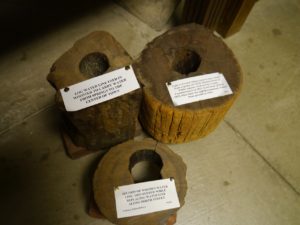
Wooster’s first water system was constructed under a contract negotiated between the original proprietors of the town and the county commissioners. One of the conditions of the contract specified that the county seat must be permanently located in Wooster. Other specifications stated that the proprietors were to bring the water which at present runs through town (by way of area creeks and or natural springs) in pipes of sound white oak timber of proper size, well bored and laid, and raise the water 10 feet above the surface of the center of town.
To construct a wood tube system the builders would often size-up the log by eye with the point of the ax then drill or bore out the center. Ramming one end to make a conical shape, they would jam the logs together in a series, use some sort of a bituminous-like pitch to then seal the line together with something like hot animal fat, or tar to caulk the joists. Sometimes they would split the log in half lengthwise and hollow it out, then put it back together and connect the logs with iron hoops, or get a blacksmith to caulk the logs with lead.
You might think wood would quickly rot but wooden pipes laid below ground need both air and water to rot. By burying the wood pipe underground and filling it with water it is denied air and the pipes could last up to 50 years or more. However, there were a few problems with the wood water line system: uneven ground below the joists could cause sags in the line where water could stagnate, the pipes would often become infested with insects or damaged by rodents, and the water sometimes acquired a woody taste.
Wooster continued to use a wood pipe water transportation system from 1815 until 1829 when the era of wood pipes gave way to the use of different pipe material after the increased pressure required to get water into growing population areas began to split the old wood pipes and the maintenance requirements brought about a need to change the water transportation system.
